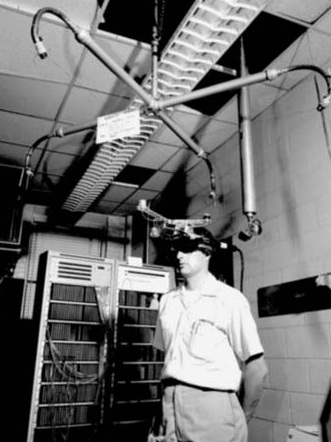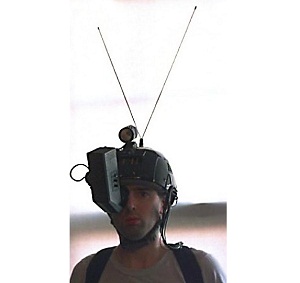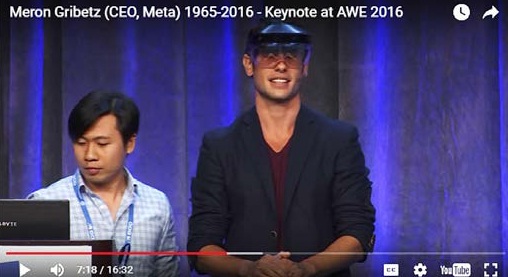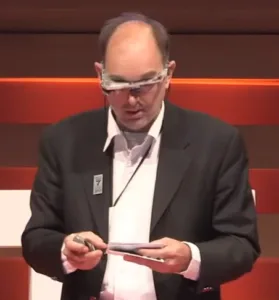
Then practice what you preach!
 The iconic ‘Sword of Damocles’ prototype AR systemIvan Sutherland and his team at Harvard University built the first AR system in 1967-68. The project was supported in part by the Advanced Research Projects Agency (ARPA). The university later published the first paper on the technology in 1968, “A Head-Mounted Three Dimensional Display.” The idea for the system, which was named the Sword of Damocles because of the gantry needed to hold it, was imagined by Sutherland in a paper he wrote for ARPA in 1965 titled “The Ultimate Display.”
The iconic ‘Sword of Damocles’ prototype AR systemIvan Sutherland and his team at Harvard University built the first AR system in 1967-68. The project was supported in part by the Advanced Research Projects Agency (ARPA). The university later published the first paper on the technology in 1968, “A Head-Mounted Three Dimensional Display.” The idea for the system, which was named the Sword of Damocles because of the gantry needed to hold it, was imagined by Sutherland in a paper he wrote for ARPA in 1965 titled “The Ultimate Display.”
The system used half-silvered mirrors in the prisms, through which the user could see both the images from miniature CRTs (on the side of the head) and objects in the room simultaneously, with a 40-degree field of view (FOV).
It took a while for the idea of AR to percolate in the minds of other investigators and researchers, and to find ways of getting the limited technology of the time to deliver the desired results. One of, if not the, first such adventurers was Steven Mann, who was at Massachusetts Institute of Technology (MIT) in the 1980s. Mann has worn an AR headset of one form or another for 38 years.
 AR was also the focus of another pioneer and long-term user, Thad Starner, who has been wearing a display for 19 years (and is famously known for the Lizzy, MIT’s first wearable, which was designed in 1992).
AR was also the focus of another pioneer and long-term user, Thad Starner, who has been wearing a display for 19 years (and is famously known for the Lizzy, MIT’s first wearable, which was designed in 1992).
Over the past couple of years, these pioneers have given talks at various conferences. Mann and Starner wore, as they always have, their AR headsets.
Mann gave an interesting presentation at TEDxToronto in September 2013, where he spoke about the legal issues of wearing and using AR. During his entire speech, on AR, while he was wearing an AR headset – he looked at cue cards! What!?
Mann talking about and wearing, but not using, ARA few years later, at yet another TED talk, Mann showed up with what presumably were Meta glasses – on his forehead.
During his entire talk, he never used the glasses – so, has Mann given up on wearing AR, which he said he had to wear and even had a physician’s prescription that he could show to cyberbullies and government representatives who didn’t take kindly to him wearing such a device?
Starner, on the other hand, at his talk (on wearable computers for Passive Learning and Rehabilitation, delivered in May 2012 at TEDxGeorgiaTech), used his AR headset the entire time. He spoke not about AR but about a haptic glove that could be used to teach you how to play the piano.
More recently, Ralph Osterhout, who founded the Osterhout Design Group (ODG) in 1999, gave the keynote at AWE 2016 and explained how we will all wear AR by 2021 and how fantastic his headset is – and yet he didn’t wear or use it at all.
Another keynote at AWE 2016 was given by Meron Gribetz, CEO and founder of Meta. After speaking for more than seven minutes (of his
16.5-minute talk), he finally put on his AR headset.
Also notice he had to be assisted in giving the demo (image below).
 Meron Grebitz, Meta CEO, demonstrating his AR glasses and new gesture capabilitiesThen, less than three minutes later, he removed the headset for the rest of his speech.
Meron Grebitz, Meta CEO, demonstrating his AR glasses and new gesture capabilitiesThen, less than three minutes later, he removed the headset for the rest of his speech.
There are two major problems with AR today: One, they are not inexpensive, and two, they are not attractive. AR is not ready for consumers yet.
When the proponents and purveyors of AR headsets won’t wear them or use them, what does that say about their functionality, utility, and maybe comfort?
What does it say about the validity of the purveyors’ arguments and pronouncements about the value and promise of AR?
Osterhout said in his AWE 2016 keynote that you don’t have to explain to aerospace companies, automobile and heavy equipment manufacturers, why being able to learn, understand, and repair just about anything anywhere in the world any time, either locally or via telepresence, is a good idea. They get the cost benefit, and are more interested in what they will save in costs of sending someone to repair something, and in the quality of the repair than the incremental cost of one HMD over another.
AR is not about entertainment, not about gaming, Osterhout commented. AR is about access to information 24/7 from anywhere in the world, and information is power (Sun Tzu).
Sounds great, sounds believable, exciting, and interesting. But why don’t you practice what you preach?
– Jon Peddie
(This article originally appeared in Jon Peddie’s Techwatch and is reprinted with permission)

